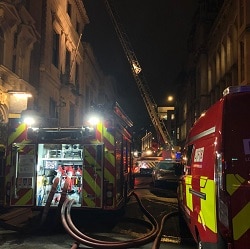
114 Chancery Lane fire: Cost of blaze put at £7.5m
The Law Society recorded an operating loss of £5.5m on its representative work for solicitors in the last financial year, its annual report has shown.
It was part of an overall deficit of £9.3m across the whole Law Society Group, including the Solicitors Regulation Authority (SRA), although the regulator itself made an operating profit of £2.1m.
In all, the operating costs of the group were £134m for the year to 31 October 2019, up from £128m the year before.
The deficit was down from £11.5m in 2018, with 2019 benefiting from “a stronger than expected return on investments” – some £7m, compared to just £1.5m in the previous 12 months.
The annual report said the deficit had been budgeted for, as it was primarily driven by the £61m IT transformation project that began in 2017 and is set to last until 2022. This is two years longer than has previously been stated.
To smooth out the cost and not cause a spike in practising fees in any year, part of the project was initially funded out of reserves – which stood at £62m last October, down from £73m the year before.
Subsequent to the year-end, the Law Society announced that the SRA would become a distinct legal entity within the group, potentially triggering a difficult debate over the division of the reserves.
The report said the society’s ruling council has also agreed to spend £5m on property refurbishment and conditionally approved £5.6m “to improve the society’s learning offer to members”.
The annual report revealed that SRA chief executive Paul Philip was paid £325,000 in salary – down from £348,000 in 2018 – but also received a pension contribution of £31,000, having not had one the previous year.
Law Society chief executive Paul Tennant was paid £239,000, plus a pension contribution of £28,000, compared to £231,000 and £3,000 in 2018.
The SRA employed 593 staff and the Law Society 395 (up from 354), while there are 49 in shared services, making a total of 1,037. The total wage bill was £56m.
In February, there was a major fire at the Law Society’s offices affecting 114 Chancery Lane – which adjoins the main 113 building. The report said the cost of repair and restoration is estimated at £7.5m, all of which – bar a £25,000 excess – will be covered by insurance.
The net book value of 114 Chancery Lane at 31 October 2019 was £2.1m.
The society’s annual general meeting and official unveiling of David Greene as the new president has been put back from July to October due to Covid-19.














Leave a Comment